Small Grains News: A Year in Review
In 2022, we spoke with farmers from five different Midwest states about a variety of topics and practices. Re-visit these featured farmers that we talked to in 2022 as we look forward to another year of learning about extended rotations from farmers across the Midwest.
January 2022: Terry Gjersvik
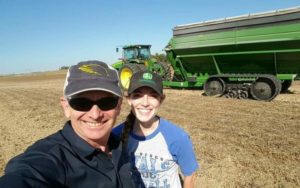 Terry Gjersvik of Alden, Minnesota started raising oats four years ago, growing between 50 and 60 acres per year. In 2022, he’s planning on seeding 270 acres – more than quadruple what he’s previously grown.
Terry Gjersvik of Alden, Minnesota started raising oats four years ago, growing between 50 and 60 acres per year. In 2022, he’s planning on seeding 270 acres – more than quadruple what he’s previously grown.
Why increase: A combination of favorable oat prices, high input costs and confidence from recent crops led Terry to make the change this year. “All these additional oat acres were going to be corn this spring,” he says, “corn has just become such a high input crop.” Terry has already forward-contracted his oats, taking advantage of the high bids released this winter.
Modifications for scaling up: This year Terry direct cut his oats for the first time. While swathing has worked well for the farm in previous years, it’s too time consuming for them to operate at a larger scale. “We have a combine with a draper head, which hopefully will be perfect,” he notes.
Livestock add value: Terry added a goat herd to his operation in 2020. In addition to grazing goats on cover crops, increasing his oat acres this year will provide him with more straw.
February 2022: David Andris
David Andris farms organically near Milford, Illinois and uses medium red clover with both his cereal rye and his oat crops. Whether frost-seeding or under-seeding, he broadcasts 15 pounds per acre of red clover with an air seeder.
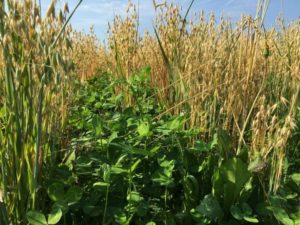 Looking for freeze-thaw weather: David knows it’s time to frost-seed when he sees temperatures forecast in the 30s during the day and the low 20s at night. In his area that’s usually late February or early March. “Get out there early in the morning and take advantage of the frozen ground. By late morning the warming temperatures and thawing ground can cause too much disturbance to your small grain seeding,” he advises. David will frost-seed the clover onto a small amount of snow, but is cautious of subsequent windy conditions, which can blow the seed around.
Looking for freeze-thaw weather: David knows it’s time to frost-seed when he sees temperatures forecast in the 30s during the day and the low 20s at night. In his area that’s usually late February or early March. “Get out there early in the morning and take advantage of the frozen ground. By late morning the warming temperatures and thawing ground can cause too much disturbance to your small grain seeding,” he advises. David will frost-seed the clover onto a small amount of snow, but is cautious of subsequent windy conditions, which can blow the seed around.
Adjusting seeding rates: David makes two passes to seed his red clover with his oats in the spring. “It’s tough to calibrate my drill accurately for both red clover and oats even with a grass seeder attachment,” he notes. He broadcasts red clover first and then comes back the same day to drill his oats. David likes to plant Reins, but they’re a shorter oat variety. To ensure the red clover is not too big by oat harvest – he’s learned the hard way that this can cause harvesting problems – David will be increasing his oat seeding rate this year from 125 to 140 pounds per acre. He hopes upping the seeding rate can keep the red clover at bay until the oats come off.
March 2022: Eric Madsen
 Eric Madsen farms with his family near Audubon, Iowa on organic and transition ground. For seeding oats each spring, he uses a base rate of 1.2 to 1.4 million live seeds per acre.
Eric Madsen farms with his family near Audubon, Iowa on organic and transition ground. For seeding oats each spring, he uses a base rate of 1.2 to 1.4 million live seeds per acre.
Adjusting seeding rates: “Generally for oats, low germination is not a problem, but you want to take note of the germ percentage when calculating seeding rates,” he notes. If they end up planting later, like the middle of April in Eric’s region, he’ll increase his seeding rate to 1.5 million live seeds per acre to encourage less tillering. Eric uses the same seeding rate with or without an underseeding, but says, “if your end goal is a 2- or 3-year alfalfa stand you may want to lower your seeding rate by 30 percent.”
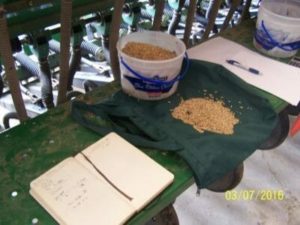 Counting seeds: Newly bought oats should come with a seed lot count, but when Eric saves back seed he’ll weigh 1,000 seeds to calculate seeds per pound. “I’ve seen oat seeding rates vary by over 32 pounds per acre due to seed counts,” he notes. Eric recalibrates his drill each year ahead of seeding, advising that “retail seeds typically run through faster because they’re better cleaned.”
Counting seeds: Newly bought oats should come with a seed lot count, but when Eric saves back seed he’ll weigh 1,000 seeds to calculate seeds per pound. “I’ve seen oat seeding rates vary by over 32 pounds per acre due to seed counts,” he notes. Eric recalibrates his drill each year ahead of seeding, advising that “retail seeds typically run through faster because they’re better cleaned.”
Planting considerations: Eric makes sure the disc openers on his Great Plains drill are sharp and properly spaced before planting. Since his drill has press wheels he doesn’t use a cultipacker. He heads out as soon as the field is firm enough to drill, ideally in mid-late March and aims for a seeding depth of 1.5 inches.
April 2022: Jake Hendrickx
 Jake Hendrickx runs a diversified crop and livestock farm in northern Minnesota where he uses diverse cover crop mixes and extended rotations. To build nutrients, soil biology, and provide forage for his cattle, Jake seeds up to 13 species in a cover crop mix following his small grains harvest. He also prioritizes winter-kill cover crops that allow him to reduce herbicide use and to save time ahead of planting corn, and uses soil tests to tailor a cover crop mix to the nutrient needs of a field. For example, using legumes to build nitrogen (N) or mustard to build sulfur.
Jake Hendrickx runs a diversified crop and livestock farm in northern Minnesota where he uses diverse cover crop mixes and extended rotations. To build nutrients, soil biology, and provide forage for his cattle, Jake seeds up to 13 species in a cover crop mix following his small grains harvest. He also prioritizes winter-kill cover crops that allow him to reduce herbicide use and to save time ahead of planting corn, and uses soil tests to tailor a cover crop mix to the nutrient needs of a field. For example, using legumes to build nitrogen (N) or mustard to build sulfur.
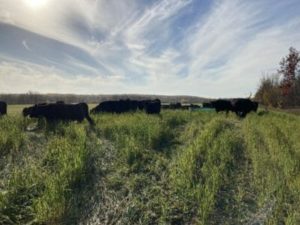 Luck with clover: Jake uses crimson clover at 3-4 lbs per acre in his cover crop mixes, which winter-kill. Particularly ahead of corn, he wants to use this clover to build N in the soil. The clover must be in the ground early to ensure the fall growth is sufficient. “If we are seeding a mix after barley or peas, the long growing season allows us to use clover. But after soybeans or edible beans we might not have a large enough window to include clover in the mix,” says Jake. If the clover happens to survive the winter it can easily be terminated in the spring with a cultivator.
Luck with clover: Jake uses crimson clover at 3-4 lbs per acre in his cover crop mixes, which winter-kill. Particularly ahead of corn, he wants to use this clover to build N in the soil. The clover must be in the ground early to ensure the fall growth is sufficient. “If we are seeding a mix after barley or peas, the long growing season allows us to use clover. But after soybeans or edible beans we might not have a large enough window to include clover in the mix,” says Jake. If the clover happens to survive the winter it can easily be terminated in the spring with a cultivator.
Reducing Applied N: Jake has cut his N-rates for corn in half over the past couple of years, from 220 lbs of N per acre to about 100 lbs per acre. “We totally switched our programming. We have NPK in the starter, but we are now more heavy on trace minerals and starter biology,” he notes. Jake plans to use a starter of 2.5 gallons per acre of CX-1, an organic biological concentrate, and 2 quarts per acre of high energy fish fertilizer made from whole fermented salmon, for nutrients.
May 2022: Denny Blowers
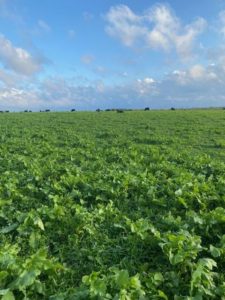 Denny Blowers of Motley, MN operates a diversified crop and livestock farm with his family. He raises 175 beef cattle and his son manages a flock of 200 ewes. To provide a diversity of forage options for their livestock they grow oats, barley, winter rye, peas, corn and summer cover crop forage mixes.
Denny Blowers of Motley, MN operates a diversified crop and livestock farm with his family. He raises 175 beef cattle and his son manages a flock of 200 ewes. To provide a diversity of forage options for their livestock they grow oats, barley, winter rye, peas, corn and summer cover crop forage mixes.
Harvest methods: Denny’s priority is to graze as much as possible: “If we don’t need to harvest a crop as feed, we will plan to graze it,” says Denny. He tries to cell- or paddock-graze the cattle and sheep, moving the animals every 3 days to once a week. When they do harvest a crop of small grains, they make baleage or haylage. “We are trying cereal grains to make better haylage for the beef and maybe the sheep, if it works,” notes Denny. Their goal is to increase protein with the peas and barley and use oats to stretch the feed.
Cover crops following small grains: After small grains harvest Denny and his son cultivate to two inches, then drill a diverse cover crop mix of 20 or more species, including sorghum, turnip and sunflowers, to name a few. This mix ensures plenty of forage over the next couple of months.
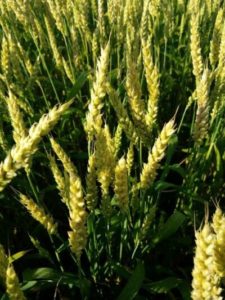 June 2022: Steve Hamman
June 2022: Steve Hamman
As small grains harvest nears, west-central Illinois farmer Steve Hamman shares his thoughts on the season and his plans for harvest.
Last fall he seeded winter wheat and cereal rye. Even with the cold, damp spring, he is expecting both small grains to be ready on time, although his crops appear shorter in stature than normal.
“I’m guessing that they will be ready the first week or two of July, which is my normal harvest window,” says Steve.
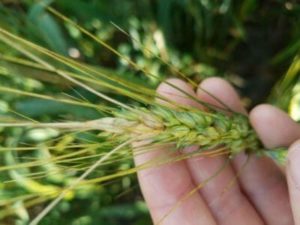 Ready for harvest? Aside from keeping his ear to the ground with the local elevator, Steve prepares for harvest by inspecting the seed heads, checking moisture levels and testing what comes through his combine. “Take a grain head and thresh in your palm. If the berries are firm then they are ready to harvest,” advises Steve. For moisture, Steve expects both rye and winter wheat to be below 13% moisture before he harvest.
Ready for harvest? Aside from keeping his ear to the ground with the local elevator, Steve prepares for harvest by inspecting the seed heads, checking moisture levels and testing what comes through his combine. “Take a grain head and thresh in your palm. If the berries are firm then they are ready to harvest,” advises Steve. For moisture, Steve expects both rye and winter wheat to be below 13% moisture before he harvest.
Harvest time: Steve prefers to direct-cut his small grains and leave his straw on the field for nutrient and organic matter retention. He plans to use his long-trusted New Holland TR99, and suggests with any combine to begin with the owners manual settings and fine tune from there by checking the grain tank and watching what is coming out of the back.
July 2022: Logan Dwyer
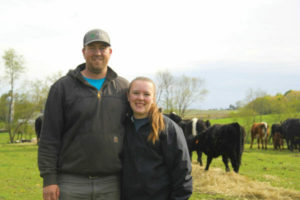 Logan Dwyer of Chetek, Wisconsin, drills diverse cover crops each summer after small grain harvest. While the exact mix changes each year, barley and cereal rye are typically at the base, and he aims to graze the cover crop with his family’s 100 head of beef cattle. “My goals are early fall growth and some overwintering. I don’t want the cover crop brown the next spring, but I don’t want it super lush either,” Logan says. Other species that are a part of Logan’s summer cover crop playbook are red clover, peas, rapeseed and turnips, and he mixes the seed himself on farm.
Logan Dwyer of Chetek, Wisconsin, drills diverse cover crops each summer after small grain harvest. While the exact mix changes each year, barley and cereal rye are typically at the base, and he aims to graze the cover crop with his family’s 100 head of beef cattle. “My goals are early fall growth and some overwintering. I don’t want the cover crop brown the next spring, but I don’t want it super lush either,” Logan says. Other species that are a part of Logan’s summer cover crop playbook are red clover, peas, rapeseed and turnips, and he mixes the seed himself on farm.
Don’t lose GDUs: “I like to drill my cover crop as soon as the small grain straw comes off,” Logan says. “That’s typically one week after small grain harvest.” In his neck of the woods, delaying seeding too long will cost him biomass. Depending on the weed pressure in his fields, Logan sometimes makes an in-season burndown pass of glyphosate and Express to help control broadleaves without residual herbicide, which could inhibit his cover crop germination.
Meter carefully: Logan aims for a seeding depth of 1 – 1.25 inches for his cover crop mixes. Seed size varies amongst species, but he hopes that larger seeds can open soil trenches for smaller seeds to emerge. Logan swears by using his Shoup seed meter on the drill to calibrate his seeding rate. And while the drill box can hold enough seed for 30 acres, he’ll only do five acres at a time, which helps ensure his seed stays evenly mixed.
August 2022: Aaron Ruwe
Winter wheat adds some diversity to the crop rotation at Aaron Ruwe’s family farm in Hooper, Nebraska. He has been working wheat into his rotations for five years; this year he’ll take the wheat to grain and harvest straw for small square bales.
 Seeding specifics: After soybean harvest, Aaron plants 40 acres of winter wheat at the end of September or the first week of October, aiming for rain in the forecast. With his no-till drill, Aaron seeds a population of 1,350,000 seeds per acre, 1-1.5 inches deep with some down-pressure adjustments if the ground is hard. Planting at the correct seed depth provides a barrier against the cold, ensuring the wheat has a better chance at over-wintering.
Seeding specifics: After soybean harvest, Aaron plants 40 acres of winter wheat at the end of September or the first week of October, aiming for rain in the forecast. With his no-till drill, Aaron seeds a population of 1,350,000 seeds per acre, 1-1.5 inches deep with some down-pressure adjustments if the ground is hard. Planting at the correct seed depth provides a barrier against the cold, ensuring the wheat has a better chance at over-wintering.
Words of advice:
- Plan to plant early: “Soybean season length will impact your timing. Choose a short-season soybean if you want to ensure your winter wheat gets in early enough.”
- Mind your herbicide:“After soybeans, be aware of the chemical residual that may remain in the field. I’ve planted winter wheat into a field with lingering residual and got a spotty stand that I had to terminate.”
September 2022: Mark and Dawn Madison
 Between perennial pasture, interseeded corn and small grains, Mark and Dawn Madison of Adrian, Minnesota, make sure they have enough grazing options for their cattle. The Madisons are currently running 75 cows on a 25 acre oat field they’ve divided into three paddocks. Their oats were underseeded with red clover but due to pressure from grasshoppers, they drilled a diverse mix after oat harvest. “We wait until the grasses are roughly 12-inches and the brassicas are 6-inches tall before we start grazing,“ Dawn says. This year it was roughly six weeks between cover crop seeding and grazing.
Between perennial pasture, interseeded corn and small grains, Mark and Dawn Madison of Adrian, Minnesota, make sure they have enough grazing options for their cattle. The Madisons are currently running 75 cows on a 25 acre oat field they’ve divided into three paddocks. Their oats were underseeded with red clover but due to pressure from grasshoppers, they drilled a diverse mix after oat harvest. “We wait until the grasses are roughly 12-inches and the brassicas are 6-inches tall before we start grazing,“ Dawn says. This year it was roughly six weeks between cover crop seeding and grazing.
Timing is everything: Mark and Dawn keep careful watch on their grazing herds and anticipate only leaving the cattle in each paddock for one or two days. “We’d like to get a second round of grazing yet this year so we want to leave at least half the biomass in the field,” they note. Grazing their summer cover crops, even if for a short period, allows their perennial pastures a rest, which they are especially grateful for during this dry season.
Mix specifics: The Madisons like to have at least six species included in all their cover crop mixes. “Medium red clover is one of my favorites because it’s proven itself to be consistent,” Dawn says. Other standbys are RTR (radish, turnips, rapeseed), flax and rye.
“Grazing cover crops is a little bit science, a little bit visual cues and a lot of guesswork,” Mark adds. “When in doubt, listen to your cows!”
October 2022: Kevin Prevo
Kevin Prevo farms with his family near Bloomfield, Iowa, where they grow corn, soybeans and cereal rye. They also raise 12,000 custom-fed hogs and have a 150 head cow-calf operation. With the time to fertilize his cereal rye fast approaching, Kevin shares his late fall hog manure application strategy. This approach allows him to curb reliance on synthetic off-farm inputs that he’s used in the past.
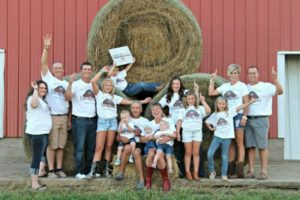 Manure timing: In late November or early December, Kevin uses a hooded splash bar to apply 1,500 gallons of hog manure to 150-200 acres of rye in 4-ft bands. This is when the “cereal rye is green and growing, just before the rye’s dormancy period,” says Kevin. His banded application provides approximately 70 lb N and 50-60 lb P and K per acre.
Manure timing: In late November or early December, Kevin uses a hooded splash bar to apply 1,500 gallons of hog manure to 150-200 acres of rye in 4-ft bands. This is when the “cereal rye is green and growing, just before the rye’s dormancy period,” says Kevin. His banded application provides approximately 70 lb N and 50-60 lb P and K per acre.
Trial and error: Too much nitrogen increases the risk of lodging in cereal rye. At his current rate of 70 units, Kevin has not had lodging issues. For those applying in spring instead of fall, he advises decreasing the N to 60 lbs. In the spring following a fall hog manure application, Kevin has observed more tillering and shoot growth, which he largely attributes to the fall phosphorus.
November 2022: Aaron Butler
 Aaron Butler operates a certified organic operation near Malta, Illinois, where he grows 3,000 acres of corn, soybeans and food-grade oats. He has a license to grow Rushmore variety oats but also explores new varieties. Each year, Aaron reviews the latest Midwest oat variety trial reports to find promising alternatives to test on his farm.
Aaron Butler operates a certified organic operation near Malta, Illinois, where he grows 3,000 acres of corn, soybeans and food-grade oats. He has a license to grow Rushmore variety oats but also explores new varieties. Each year, Aaron reviews the latest Midwest oat variety trial reports to find promising alternatives to test on his farm.
What to look for: “The number one factor is a good test weight, which is especially important when selling oats into a food-grade market. We are also looking for a good disease package. We are organic; we need something that can hold up in a year with high disease pressure.”
Market specs: After harvest, Aaron works with Grain Millers to determine milling quality and milling yield of his trial oat varieties. He’s found that some varieties aren’t worth milling. “We grew out Antigo and they didn’t end up milling well; the berries were too small.”
Final considerations: “When reviewing variety trial data don’t forget to consider your local climate; not all varieties are transferable within the Midwest. “We once tried a late-season variety that worked well in the Dakotas but it did not work in Illinois!”
Thank you to all the farmers that shared their stories in 2022!
If you want to share your story in 2023, please contact: Taylor.Hintch@PracticalFarmers.org
